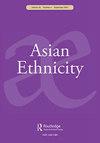作为表演的移民青年身份:泰国多民族教育中的着装规范和造型
IF 0.8
Q3 ETHNIC STUDIES
引用次数: 0
摘要
摘要本文关注学校的服装政策,以此来理解泰国政府对多样性的管理,以及年轻移民在国家民族主义话语中如何驾驭自己的归属感。由于移民学生群体的多样性,泰国一所公立学校宣称自己是一所多元文化的学校,并指示学生每周二穿“民族服装”(chut pracam chat)。这项政策使移民儿童能够进入一个缅甸移民被排斥在外的文化领域,但具有讽刺意味的是,同样的衣服同时给他们打上了raeng ngan tangdao的印记,字面意思是“外来工人”。年轻移民制定策略,淡化他们在公共场所的争吵,质疑归属感和真实性。他们的着装实践揭示了戏剧化和转瞬即逝的身份表演。但他们既没有完全融入国家标准,也没有主张完全不同的身份。本文章由计算机程序翻译,如有差异,请以英文原文为准。
Migrant youth identities as performances: dress codes and styling in Thai multi-ethnic education
ABSTRACT This paper focuses on clothing policy in schools as a means to understand the Thai state’s management of diversity as well as the ways in which young migrants navigate their belongingness within the state discourse of nationalism. Because of its diverse migrant student population, a Thai state school proclaims itself a multicultural institution and instructs its students to wear ‘national clothes’ (chut pracam chat) every Tuesday. This policy enables migrant children to enter a cultural sphere where Burmese migrants are excluded, but, ironically, the very same clothes simultaneously stamp them as raeng-ngan tangdao, literally translated as ‘alien workers’. Young migrants devise strategies to downplay their alterity in public spaces and question the idea of belongingness and authenticity. Their dress practices reveal theatrical and fleeting performances of identity. But they neither fully assimilate to national standards nor assert completely distinct identities.
求助全文
通过发布文献求助,成功后即可免费获取论文全文。
去求助
来源期刊

Asian Ethnicity
PHYSIOLOGY-
CiteScore
2.80
自引率
6.20%
发文量
27
期刊介绍:
In the twenty-first century ethnic issues have assumed importance in many parts of the world. Until recently, questions of Asian ethnicity and identity have been treated in a balkanized fashion, with anthropologists, economists, historians, political scientists, sociologists and others publishing their studies in single-discipline journals. Asian Ethnicity provides a cross-disciplinary, international venue for the publication of well-researched articles about ethnic groups and ethnic relations in the half of the world where questions of ethnicity now loom largest. Asian Ethnicity covers any time period, although the greatest focus is expected to be on the twentieth and twenty-first centuries.
 求助内容:
求助内容: 应助结果提醒方式:
应助结果提醒方式:


